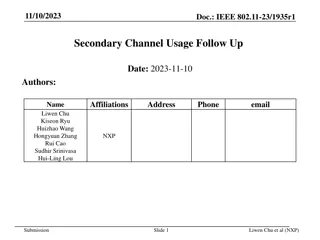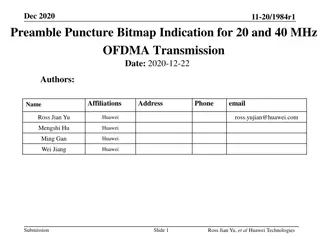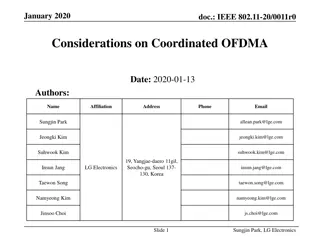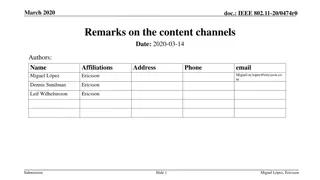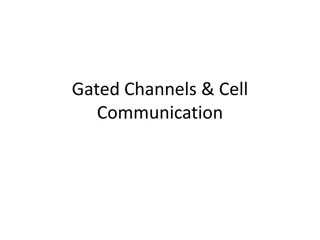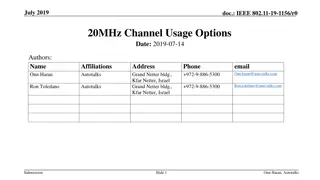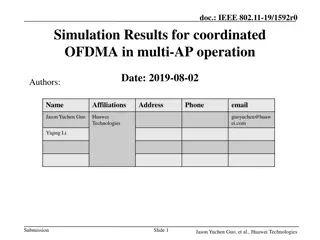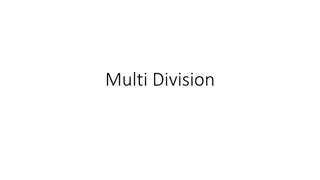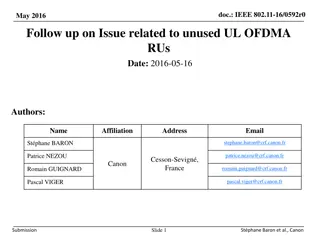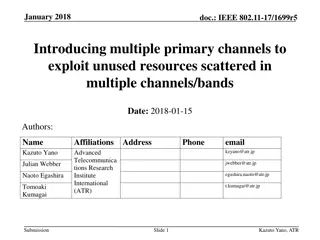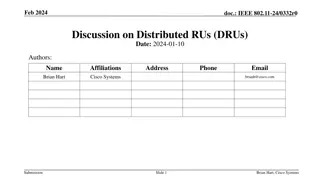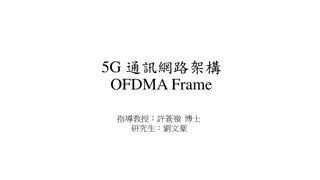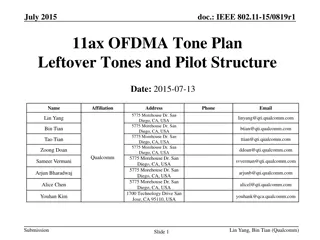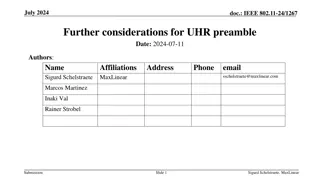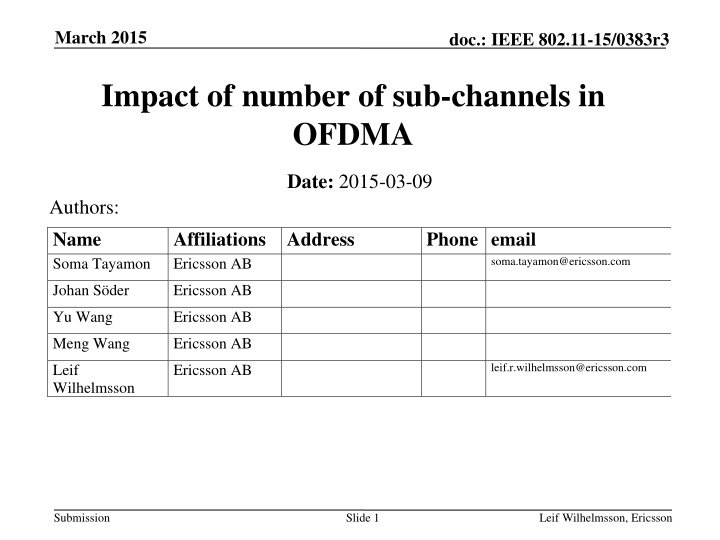
Impact of Sub-Channel Number on OFDMA Gain in IEEE 802.11-15
This document discusses the impact of the number of sub-channels on the gain achieved by implementing OFDMA in IEEE 802.11-15 standards. It analyzes the gains related to reduced overhead and frequency selective scheduling for different packet sizes and loads. The study includes expected gains from calculations, simulation results for full and finite buffer scenarios, and the methodology used to determine the gains from frequency selective scheduling.
Download Presentation

Please find below an Image/Link to download the presentation.
The content on the website is provided AS IS for your information and personal use only. It may not be sold, licensed, or shared on other websites without obtaining consent from the author. If you encounter any issues during the download, it is possible that the publisher has removed the file from their server.
You are allowed to download the files provided on this website for personal or commercial use, subject to the condition that they are used lawfully. All files are the property of their respective owners.
The content on the website is provided AS IS for your information and personal use only. It may not be sold, licensed, or shared on other websites without obtaining consent from the author.
E N D
Presentation Transcript
March 2015 doc.: IEEE 802.11-15/0383r3 Impact of number of sub-channels in OFDMA Date: 2015-03-09 Authors: Name Soma Tayamon Affiliations Address Ericsson AB Phone email soma.tayamon@ericsson.com Johan S der Ericsson AB Yu Wang Ericsson AB Meng Wang Ericsson AB leif.r.wilhelmsson@ericsson.com Leif Wilhelmsson Ericsson AB Submission Slide 1 Leif Wilhelmsson, Ericsson
March 2015 doc.: IEEE 802.11-15/0383r3 Abstract This contribution presents some results for how the number of sub-channels impacts the gain obtained by introducing OFDMA in two aspects First, the gain obtained through reduced overhead for various packet sizes and loads Second, the potential gain obtained through frequency selective scheduling (FSS) for channels with various delay spread Submission Slide 2 Leif Wilhelmsson, Ericsson
March 2015 doc.: IEEE 802.11-15/0383r3 Outline Gain obtained from reduced overhead Expected gains from simple calculations for full buffer Simulation results full buffer Simulation results finite buffer Gain obtained from FSS Methodology Simulation results Conclusions Submission Slide 3 Leif Wilhelmsson, Ericsson
March 2015 doc.: IEEE 802.11-15/0383r3 Expected gain 11ac parameters Assuming MCS 9, 2 spatial streams, 20 MHz, 52 data subcarriers (173.3 Mb/s) Overhead: DIFS + mean(backoff) + PHY_header = 145.5 s Data: 78 B/OFDM symbol, 3.6 s/OFDM symbol (short GI) 50 B packet, system throughput: Single transmission: 1.8 Mb/s 2 OFDMA receivers: 2.6 Mb/s 4 OFDMA receivers: 3.5 Mb/s 1 kB packet, system throughput: Single transmission: 30 Mb/s 13 OFDM symbols 2 OFDMA receivers: 41 Mb/s 26 OFDM symbols 4 OFDMA receivers: 50 Mb/s 52 OFDM symbols 1 OFDM symbol 2 OFDM symbols 3 OFDM symbols Submission Slide 4 Leif Wilhelmsson, Ericsson
March 2015 doc.: IEEE 802.11-15/0383r3 Expected gain 11ac parameters Mean user throughput with and without OFDMA 140 50 200 1000 8000 120 Estimated gain with OFDMA [%] 100 2 users, 50B 4 users, 50B 2 users, 1kB 4 users, 1kB 80 Re- ference 0.9 Mb/s 0.45 Mb/s 15 Mb/s 7.5 Mb/s 60 OFDMA 1.3 Mb/s 0.9 Mb/s 20.5 Mb/s 12.5 Mb/s 40 Gain 44% 100% 37% 67% 20 0 1 2 3 4 5 6 7 8 Number of users Submission Slide 5 Leif Wilhelmsson, Ericsson
March 2015 doc.: IEEE 802.11-15/0383r3 Simulations: Traffic Scenarios Full Buffer Finite Buffer 1 AP, multiple STAs 20 MHz BW: 52 data subcarriers Fixed MCS = 9, Nss = 2 Max nr of receivers per OFDMA frame: 5 (if less receivers available, subcarriers split between them) UDP traffic model Throughput = packet size/delay time 1 AP, multiple STAs 20 MHz BW: 52 data subcarriers Fixed MCS = 9, Nss = 2 Number of users per OFDMA frame: number of users in the system 100% DL OFDMA transmission opportunity Submission Slide 6 Leif Wilhelmsson, Ericsson
March 2015 doc.: IEEE 802.11-15/0383r3 OFDMA Gain with Full Buffer 80 1 kB OFDMA 1 kB Non-OFDMA 8 kB OFDMA 8 kB Non-OFDMA 60 140 Relative gain with OFDMA transmission [%] 40 120 Average user trpt (Mb/s) 20 100 0 2 3 5 8 80 6 50 B OFDMA 50 B Non-OFDMA 200 B OFDMA 200 B Non-OFDMA 60 50 B 200 B 1 kB 8 kB 4 40 2 20 0 0 2 3 5 8 2 3 5 8 Number of users Number of users Higher relative gains obtained with smaller data packets & more users per transmission Gains close to theoretical calculations (slightly lower) Submission Slide 7 Leif Wilhelmsson, Ericsson
March 2015 doc.: IEEE 802.11-15/0383r3 OFDMA Gain with Finite Buffer Relative gain with OFDMA transmission [%] 45 80 50B 200B 1kB 40 70 Average user throughput [Mb/s] 35 60 30 50 25 40 20 30 15 20 10 50B 200B 1kB 10 5 0 0 0 500 1000 1500 2000 50 200 500 1000 2000 User arrival rate [1/s] User arrival rate [1/s] For low user arrival rates gains are very small, ~2% for 200 packets/s (For 200 packets/s ~2% of transmissions are OFDMA) Relative gain up to 80% for high user arrival rates. Congestion at the high user arrival rates and larger packet sizes. Submission Slide 8 Leif Wilhelmsson, Ericsson
March 2015 doc.: IEEE 802.11-15/0383r3 OFDMA Gain with Finite Buffer Zoom in Throughput gain versus offered traffic. Due to low efficiency the system gets congested already at very low traffic loads with small file sizes Submission Slide 9 Leif Wilhelmsson, Ericsson
March 2015 doc.: IEEE 802.11-15/0383r3 Illustration of Congestion at AP User arrival rate: 500 users/s file size 1 kB. OFDMA reduces channel utilization Blue: OFDMA and red: Non-OFDMA. Exact same traffic arrival pattern used in both cases Submission Slide 10 Leif Wilhelmsson, Ericsson
March 2015 doc.: IEEE 802.11-15/0383r3 Channel usage 90 How congested is the system? 80 70 Mean channel usage [%] Mean channel usage increases with the number of user arrivals. The mean usage reaches 80% for the high user arrival rate. Dashed line indicates the OFDMA results. The channel usage decreases from ~80% to ~65% for the high user arrival intensity (2000 users/s) 60 50 40 30 20 50B 200B 1kB 10 0 50 200 500 User arrival intensity [1/s] 1000 2000 Submission Slide 11 Leif Wilhelmsson, Ericsson
March 2015 doc.: IEEE 802.11-15/0383r3 Impact of Max # of sub-channels 4000 1kB with 2000 users/s Results indicate that the maximum number of OFDMA receivers is used. For high user arrival intensities, more number of OFDMA receivers per frame yields higher user throughput. 3 OFDMA receivers (as a maximum value) is needed to achieve higher user throughput for arrival rates up to 1000 users/s. 3500 3000 Number of packets 2500 2000 1500 1000 500 0 1 2 3 4 5 6 7 8 9 Number of OFDMA receivers 2.8 2.6 Average user throughput [Mb/s] 2.4 2.2 2 1.8 200 /s 500 /s 1000 /s 2000 /s 1.6 1.4 1.2 1 1 2 3 4 5 6 7 8 Max nr of OFDMA receivers Submission Slide 12 Leif Wilhelmsson, Ericsson
March 2015 doc.: IEEE 802.11-15/0383r3 Summary reduced overhead For full buffer, the obtained gain is very close to what is easily predicted by theory For finite buffer, the burstyness of the traffic may cause issues already at low load. Especially for small packets Simulations with maximum 5 channels indicate that perhaps 8 sub-channels would be reasonable Submission Slide 13 Leif Wilhelmsson, Ericsson
March 2015 doc.: IEEE 802.11-15/0383r3 Frequency Selective Scheduling With larger number of sub-channels, it is at least in theory possible to make the FSS more effective The idea is to see how the much difference it makes to increase the number of sub-channels for some different delay spreads 20 MHz channel assumed in all cases Perfect channel knowledge 25 ns, 100ns, and 400 ns delay spread Submission Slide 14 Leif Wilhelmsson, Ericsson
March 2015 doc.: IEEE 802.11-15/0383r3 FSS - Methodology Here we fix the number of users, and vary the number of sub-channels. This means that the number of transmissions will be: #users/#sub-channels The efficiency increase by having fewer transmission in case of more sub-channels is not accounted for (this was the first part of the presentation) Submission Slide 15 Leif Wilhelmsson, Ericsson
March 2015 doc.: IEEE 802.11-15/0383r3 RMS delay spread = 25 ns 2 sub-channels not enough Relative gain decrease with SNR About 15% gain at 15 dB with 4 sub-channels and 8 users Submission Slide 16 Leif Wilhelmsson, Ericsson
March 2015 doc.: IEEE 802.11-15/0383r3 RMS delay spread = 100 ns >4 sub-channels is beneficial Relative gain increased compared to 25ns case About 30% gain at 15 dB with 8 sub-channels and 8 users Submission Slide 17 Leif Wilhelmsson, Ericsson
March 2015 doc.: IEEE 802.11-15/0383r3 RMS delay spread = 400 ns 16 sub-channels do ideally give gains Up to 40% gain at 15 dB with 16 sub-channels and 16 users 8 sub-channels worse than for 100ns channel Submission Slide 18 Leif Wilhelmsson, Ericsson
March 2015 doc.: IEEE 802.11-15/0383r3 Summary FSS For small delay spread, 25 ns, 4 sub-channels seem as a reasonable complexity-performance trade-off. Gain of 15% at 15 dB, higher for lower SNR For large delay spread, 100 ns, 8 sub-channel can be justified performance-wise. Gain of 30% at 15 dB For very large delay spread, 400 ns, as much as 16 can be justified with a gain of 40% at 15 dB Submission Slide 19 Leif Wilhelmsson, Ericsson
March 2015 doc.: IEEE 802.11-15/0383r3 Conclusions The impact the number of sub-channel has in case of OFDMA was studied, looking into The potential gain from reduced overhead The potential gain from FSS If support for small packets is one of the key targets, 8 sub-channels in 20 MHz seems reasonable. The gain from FSS depends on SNR. Gains of 15-40 % seems reasonable at SNR = 15 dB Number of sub-channels should likely be determined by the support for small packets, not FSS, as the gain is more easily achieved Submission Slide 20 Leif Wilhelmsson, Ericsson
March 2015 doc.: IEEE 802.11-15/0383r3 References 1. 11-14/0855r0, Techniques for short downlink frames 2. 11-14/0858r0, Analysis on Multiplexing Schemes exploiting frequency selectivity in WLAN Systems 3. 11-14/1227r3, OFDMA Performance Analysis 4. 11-14/1452r0, Frequency Selective Scheduling in OFDMA Submission Slide 21 Leif Wilhelmsson, Ericsson

